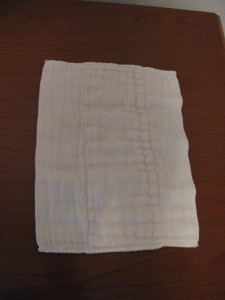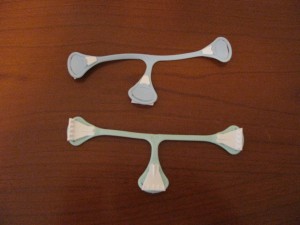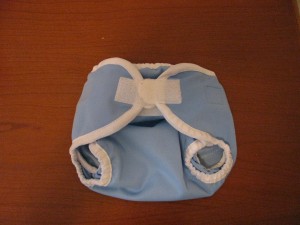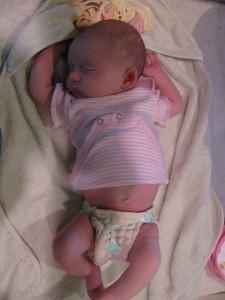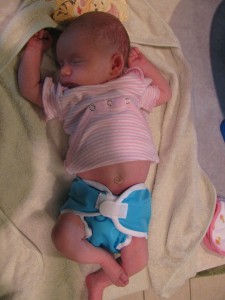One decision we made early in our pregnancy was to use cloth diapers instead of disposables. There are a variety of reasons that people elect to use cloth diapers but our primary reason was cost. I’d read that the average family spends more than $2000 on disposable diapers until the child is potty trained. That’s a lot of money on diapers!
After doing extensive research online, we committed to using cloth diapers with McKamy. One of the most interesting benefits that is touted online is that babies who use cloth diapers tend to have much milder or no diaper rash. As this can be really painful for the baby, I was definitely interested to read this. There are a couple theories for this, but primarily it seems to be true because parents who use the cloth instead of disposable tend to change the diapers much more frequently than other parents. Whether this is because they are paying more attention to it, the cloth doesn’t hide the evidence as well, or another reason I can’t say.
As a side note, I had a small degree of concern about using the disposable diapers for one reason – chemicals. These chemicals have been suggested as a possible cause of the diaper rash as well. As more and more kids are being diagnosed with learning disorders, ashthma, and other health complications, the medical community hasn’t been able to pinpoint what is causing the changes. Honestly? It might just be a widening of the what is diagnosed as a condition. I certainly don’t know. But, it can’t hurt to cut out unnecessary chemicals from every day use.
Fortunately McKamy hasn’t had any major problems with diaper rash, so that makes me one happy Momma!
There are a zillion different kinds and brands of cloth diapers. It certainly was a task to hunt through all the information and make a decision! We finally decided to go with the basic cotton prefold diaper with a diaper cover. There is an additional step to cloth diapering as compared to disposable diapers, but it really isn’t any harder to do and by now we are getting pretty quick at it too!
There are 3 parts to our cloth diapers — the prefold or trifold cloth diaper, a Snappi to hold it in place, and the diaper cover. I opted to purchase the Thirsties Duo brand diaper cover because it has several different sizes built into the cover so it can grow with her. There are only two sizes of these covers to last McKamy through potty training, so I only need to purchase these covers twice. The size 1 covers (the ones I am currently using) are designed to last through about 18 lbs.
The Snappi is a really cool little tool. It works basically the same way the hooks on an Ace bandage wrap do. It’s got little plastic teeth that grip the cloth diaper and hold it in place. By stretching it between the two outer tabs of the diaper and then between her legs, it holds the cloth diaper nice and snugly against her and we don’t really have to worry about leaks. And it’s a LOT easier to use than safety pins.
Cloth diapers have already proven to be a good option for us. We are using upwards of 20-25 diapers per day. This is definitely a lot! I am pretty much running a load of diapers every day to keep up and we were initially having to use some disposable diapers to bridge the gap when I ran out. Compared to disposables though, it’s made a huge difference. One box of Huggies disposable diapers (84 in the package) is about $20. At this rate, we’d be using an entire box every 3-4 days and spending nearly $40 per week on these diapers. In comparison, I’ve spent about $180 total on the cloth diapers which should last us for months. Now, I know that we’ll start using fewer and fewer diapers as she grows, but the initial comparison was striking to me.
Yes, using cloth diapers means that our poor washing machine is working double time to keep up. But that’s okay — that’s what a washer is for! And now we are glad that we opted to buy a high efficiency front loading washer when we bought the set five years ago. It does a great job. We run the diapers through a cold wash cycle and then a hot wash cycle and pop them directly into the dryer. It takes about 2 hours to run the entire load and get it dry (30 minutes in cold, 60 minutes in hot, and another 30 – 45 minutes to dry them) but it’s one of those tasks you start and walk away. Running them at night seems to work pretty well for us because I start the load at one feeding before I go to bed, reset for the hot wash when she wakes up and is hungry again, and then move to the dryer on the third time. I’m up anyway and that way I don’t have to wait for the load to finish.
Here’s step one:
And the finished product:
What a great little model!
